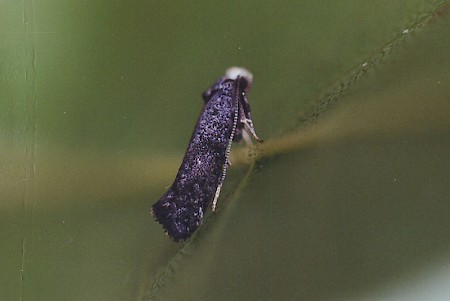16.02 BF441
Paraswammerdamia nebulella
(Goeze, 1783)
[Synonyms: Paraswammerdamia lutarea]Wingspan 11-14 mm.
This small greyish moth with a white head is a fairly common species throughout Britain except the far north. It flies at night during July, and is frequently taken at light.
The larval foodplants are mainly hawthorn (Crataegus), and rowan (Sorbus aucuparia), with one or two others.
The larva overwinters when small.
- Larva: (description Ian F. Smith):
Foodplants: Crataegus and Sorbus aucuparia. Sometimes Rosa or Cotoneaster horizontalis (MBGBI 3). September; leaf mine. October - March; white spinning on twig. Late April - early June; under web on a leaf, when it may be easily obtained by beating.
Length: 8 mm described. 6 mm and 10 mm specimens, similar but paler.
Head: Brown ochre with darker (raw umber) mottling dorsally and laterally. Pitchy brown posterolateral mark. Clypeus whitish. Stemmatal area blackish. Vertical triangle white.
Prothoracic shield: Blackish brown, except for light brown area either side of anterior half of medial line (Some 10 mm specimens almost all light brown). Medial line pure white, widest on anterior margin and posterior half of shield. Narrow border of integument in front of shield tinted pinkish.
Thorax (T1,2,3): Thorax markedly thinner than abdomen. Bold pure white lateral line.
Thoracic legs: Shagreened. Femur and tibia blackish. Tarsus translucent brown.
Body: Opaque; all colours on cuticle. Thin dorsal line indian red (dull red). Subdorsally yellow ochre and burnt ochre. Dorsolaterally van dyke brown (dark brown). Laterally burnt ochre (10 mm, pinkish). The white lateral line of the thorax continues more narrowly on segment A1 and the anterior of A2, and is represented on A3 to A7 by a white intersegmental spot, before resuming as an indistinct line on A8, A9 and anterior of A10. Subventrally dark purplish brown, paler ventrally.
Spiracles: Small, discernible under magnification. Yellowish peritreme. Largest on A8 and T1.
Pinacula: White with black setal spot.
Setae: Translucent brown.
Anal segment: The van dyke brown of the dorsolateral band continues, with a more reddish tint, onto A10 around the anal plate and down the anal prolegs. Anal plate mottled whitish and light brown with black setal spots.
Prolegs: Base and planta whitish translucent. Base has a purplish brown (10 mm, blackish) collar distally on the outer face. Crochets black. Anal proleg coloured as dorsolateral band with a more reddish tint. A large mark, pitchy brown with a whitish edge and black setal spots, curves down the outer face of the anal proleg and across its anterior.
Pupa: June. 5 mm. In a strong almond shaped white silk cocoon among flimsier silk on a twig, in a folded leaf or between sewn leaves.

 UKMoths
UKMoths 







